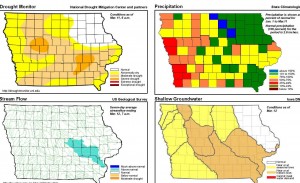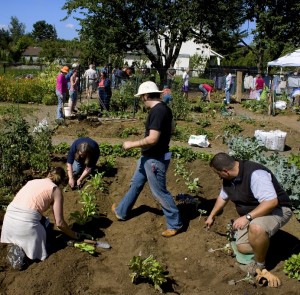CLICK HERE for the latest market quotes from the Iowa Agribusiness Network!
CLICK HERE for the latest market quotes from the Brownfield Ag News Network!
CLICK HERE for the latest market quotes from the Iowa Agribusiness Network!
CLICK HERE for the latest market quotes from the Brownfield Ag News Network!
The Iowa Department of Natural Resources reports precipitation for Iowa is below normal so far in 2014, receiving an average of 2.2 inches instead of the normal 2.6 inches by this time. The wettest area of the state is extreme southeast Iowa with 5 inches of moisture, and the driest areas are portions of the I-29 corridor which have received only about an inch.
Stream flows are normal across the state for this time of year, except in the Iowa River watersheds, which are above normal.The area of extreme drought in Iowa has reduced in size from 20 percent of the state to 7 percent since the beginning of the year.
For a more thorough review of Iowa’s water resource trends January 1 through March 12, go to http://www.iowadnr.gov/watersummaryupdate. The report is prepared by the technical staff from the Iowa DNR, the Iowa Department of Agriculture and Land Stewardship, and the U.S. Geological Survey, in collaboration with The Iowa Homeland Security and Emergency Management Department.
The Iowa Senate’s Agriculture Committee this week approved a bill that would allow the so-called “corn check-off” go as high as three-cents per bushel. Iowa Corn Growers Association lobbyist Mindy Larsen Poldberg, says current state law limits the check-off to one-cent per bushel. “Farmers, they know that they’re currently paying one cent per bushel after the last refendum in 2012,” Larsen Poldberg says. “There could never be another referendum again, even if farmers wanted it, unless this bill passes.”
A bill creating the corn check-off — requiring farmers to pay a small portion of what they earn on each bushel of corn sold if farmers approve the move in a referendum — passed the Iowa legislature in 1976. In 1977, Iowa farmers voted to send one-tenth of a cent from each bushel sold to the Iowa Corn Promotion Board. Since then farmers have voted four times to raise the check-off, but it now sits at the maximum allowed by law.
“And what this bill is trying to do by raising that cap to three cents is plan for the next 40 years,” Larsen Poldberg says, “or at least a few decades out.” The bill has already cleared the Iowa House and now is eligible for debate in the Iowa Senate. The bill’s managers say about 51 million dollars would have been raised in 2013 if Iowa farmers were paying that top three-cent-per-bushel check-off rate. For farmers who might have sticker shock at that number, Larsen Poldberg says that upper threshold won’t be reached anytime soon.
“The goal is not to pass this bill and then immediately raise the check-off to three cents,” Larsen Poldberg says. “That is not going to happen.” Check-off funds are managed by a group of farmers who’ve been elected to the Iowa Corn Promotion Board. Over the past four decades the board has used the check-off money to encourage use of high-fructose corn syrup and corn-based ethanol. The money also is used for research to find new uses for corn.
(Radio Iowa)
Think Spring! The Cass County Master Gardeners and Cass County Extension are helping local gardeners gear up for warmer weather this month, with the 16th Annual Atlantic Spring Garden Seminar on Saturday March 22nd. This full day event, held at the Atlantic High School, features garden experts from across the Midwest sharing the latest information on gardening methods and plant varieties. The seminar is open to all interested gardeners no matter the level of experience. Participants are not required to have completed Master Gardener training to attend, but Master Gardeners who attend the full day will be given 5 credit hours toward their continuing education requirements.
The seminar is open to all interested gardeners no matter the level of experience. Participants are not required to have completed Master Gardener training to attend, but Master Gardeners who attend the full day will be given 5 credit hours toward their continuing education requirements.
The day starts with registration and refreshments at 8:30 AM. The program begins at 9 AM, when freelance garden writer Susan Appleget-Hurst will discuss “Dream Garden Design”, sharing practical tips for bringing inspiration to your home garden. The first of two breakout sessions for the day is next, and attendees will have 10 different topics to choose from, covering everything from starting seeds to native plants, and creating garden totems to focusing on care for specific plants. Before lunch, attendees will gather back in the auditorium to hear about tree selection for Iowa from ISU Extension Forestry Specialist Jesse Randall.
Over the lunch break, participants can browse the vendor/exhibitor booths in the high school gym, visit a Q & A booth to chat with some of our expert presenters, and enjoy lunch while chatting with friends or making new acquaintances.
The final group session for the day features Deb Groth of Groth Gardens in Winterset discussing tips and trick for growing “wow-worthy” containers. Before attendees head home, they will attend one more breakout session where they can pick from a list of 9 different topics to round out their day. The final session will wrap up by 3:20 PM.
The cost for this day of fun and learning is $35, including all meals and session materials. A full list of all breakout sessions, a schedule for the day and printable registration form are all available online at www.extension.iastate.edu/cass or can be picked up at the Cass County Extension Office. Brochures are also available at many local businesses with the schedule and registration form.
Registrations are welcome up to the day of the Garden Seminar, including walk-in registrations at the door. For more information on the Spring Garden Seminar or the Cass County Master Gardener Program, call the Cass County Extension Office at 712-243-1132, email keolson@iastate.edu, or stop by the Extension Office at 805 W. 10th St in Atlantic.
DENISON, Iowa (AP) – Tyson Foods has changed its plans and has decided to keep open its beef plant in Denison. Officials say the decision will save nearly 400 jobs in the western Iowa city of about 8,400 people. Tyson spokesman Gary Mickelson said Thursday that employees were given the good news last week.
Two years ago Tyson said the aging slaughterhouse could close after completion of a $90 million expansion and modernization project at Tyson’s beef plant in Dakota City. The Dakota City project originally was expected to be completed in mid-2013, but it’s taken longer than anticipated. Completion now is expected this summer.
Tyson says reasons to keep open the Denison plant include the closing of some competitors’ beef plants and the lower feed prices for cattle.
The Fire Weather Danger Index for much of far west and southwest Iowa and eastern Nebraska will be in the VERY HIGH category today! Emergency Management officials say you should be extremely cautious if you plan to burn outdoors today. There are currently no Burn Bans in effect, but officials say if the dry weather continues throughout the next few weeks that could change.
Emergency Management officials say you should be extremely cautious if you plan to burn outdoors today. There are currently no Burn Bans in effect, but officials say if the dry weather continues throughout the next few weeks that could change.
In anticipation of the rapid drying conditions forecast for this weekend, Shelby County Emergency Management officials say they will begin bi-weekly local fire danger assessments, next week.
Spring cleanup time is traditionally when a lot of people burn their brush piles.Officials say being aware of the potential for that small fire to spread due to wind and other meteorological conditions, conducive to rapid fire spread, is what the Fire Danger Assessment Program is all about. Monitoring the burning conditions will allow authorities to advise residents as to whether a controlled, open burn should be put off to a more favorable day, and save area volunteer firefighters from leaving their jobs for a burn which becomes uncontrollable.
Shelby County Emergency Management asks you to please call your controlled burns in to the Emergency Management Agency at 712-755-2124. Officials will take your information and put you in touch with the Fire Chief in your community.
By Haley Carlson
The Atlantic FFA took eight members to District Convention in Denison on Saturday, March 8, 2014. The members participated in a variety of events from quizzes to competitions to chapter delegates. Juniors, Adam Freund and Clint Hansen took the Farm Business Management Quiz, Freund placing 3rd and Hansen placing 4th. Freund also participated in Ag Broadcasting, earning a Bronze. Freund said, “Broadcasting was difficult but I thought I did well”. Hansen took part in the Extempt Speaking contest, earning a Bronze. Four of Atlantic’s freshman FFA members took the Greenhand quiz, Nate Moen placing 25th, Morgan Barkley placed 27th, Haylee Valekia placed 28th, and Colby Sorenson placed 30th. Moen said, “This was my first official FFA event and I had a lot of fun. I hope to be able to compete in more events in the coming years”. Sophomores, Clayton Saeugling and Haley Carlson were the chapter delegates for Atlantic FFA at convention. A delegate is someone who sits in on the speeches of new district officer candidates and also votes on these candidates. Delegates also approve the secretary and treasurer’s report. Saeugling thought “it was a fun and memorable experience”. The Atlantic FFA chapter will be traveling to Iowa FFA State Convention from April 27-29.
The Gleaves family of Oakland was recognized Monday as recipients of the ‘ Gary Wergin Good Farm Neighbor Award’ during a ceremony at the Oakland Community Center. Iowa Secretary of Agriculture Bill Northey presented the Terry and Amy Gleaves family with the award in front of more than 70 family members, friends and neighbors.
Gleaves said that he was “Honored and humbled” to receive the award.” He added, “Growing up on the farm all the neighbors helped each other out – whether it was vaccinating cattle or chopping silage – all the neighbors pitched in to help. It was a real neighborhood effort to get the work done. This award is not only for me, but for all of my neighbors as well.”
The Wergin Good Farm Neighbor award, sponsored by the Coalition to Support Iowa’s Farmers (CSIF), recognizes Iowa livestock farmers who take pride in doing things right. That includes caring for the environment and their livestock and being good neighbors. The Gleaves have a cow-calf herd and operate a row-crop farm in Pottawattamie County. Becky Lockwood nominated the Gleaves for the award for being a great farm family that has a strong commitment to the community and their neighbors.
The Wergin Good Farm Neighbor Award, presented by the Iowa Department of Agriculture and Iowa Ag Radio Network in partnership with CSIF, is presented nine times annually to an Iowa farm family who raises livestock. It’s given in honor of distinguished farm broadcaster Gary Wergin and recognizes families who take pride in being good neighbors and stewards of the land.
A decision Monday by the U-S Supreme Court to turn abandoned rail lines which have been granted easements from the U-S, over to property owners on either side of the right-of-way, won’t affect two popular southwest Iowa trails that run on former railroad rights-of-way. The Daily NonPareil reports that neither the Wabash Trace Nature Trail, which runs from Council Bluffs to the Missouri state line, nor the Old Stone Arch Nature Trail near Shelby will be forced to turn over ownership of the paths to adjacent landowners.
According to Marianne Fowler, senior vice president of federal relations for the Rails-to-Trails Conservancy, southwest Iowa’s pair of trails were exempted from the ruling for different reasons. The 63-mile Wabash Trace, which runs through four counties, is safe because it’s part of the “railbank” system. Becca Castle, president of Southwest Iowa Nature Trails told the paper that since the former Wabash Railroad purchased the land from the government, it wouldn’t have been affected by the ruling. Out-of-service railroad lines are sold, leased or granted to agencies that oversee a trail.
Ownership never changes hands, however, because the rail company reserves the right to one day reopen a railroad line on the land if need be. More than 4,400 miles of railroad corridors in 33 states are operated as part of this system, according to the Rails-to-Trails Conservancy. If abandoned, ownership of that land would ordinarily have reverted to neighboring landowners.
Lisa Hein, program and planning director for the Iowa Natural Heritage Foundation, which oversees the Wabash Trace and much of the state’s converted rail trails, said most Iowa rail trails are railbanked, and those weren’t affected by the ruling because the railroad company could still operate a line on the land.
Renee Hansen of the Shelby County Auditor’s Office, told the NonPareil that the Old Stone Arch trail – a small portion of the former Chicago, Rock Island and Pacific Railroad right-of-way in Pottawattamie and Shelby counties – was privately granted easements in 1867 and 1968, therefore, the four-mile stretch of trail now owned by the city was also not affected by the decision.
As a whole, Iowa – which has nearly 1,000 miles of trails on converted railroad property – looks to see little or no effects by the 8-1 Supreme Court decision. Justice Sonia Sotomayor was the lone dissenter.